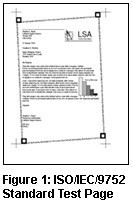ISO Page Yields
Background
In December 2006, the International Organization for Standardization (ISO) body approved new standards for ink (ISO/IEC 24711) and color toner (ISO/IEC 19798) printer cartridge page yield measurements. These new standards complement the ISO/IEC 19752 yield standard for monochrome toner printer cartridges published in June 2004.
The ISO standards for ink and toner cartridge yields clearly define the key attributes that affect yield and apply robust statistical analysis to the results. All printer manufacturers are now able to utilize the same methodology when measuring cartridge yield.
Details of the ISO/IEC standards are available on the Web site www.iso.org/jtc1/sc28.
What is page yield?
Page yield is the total number of pages that can be printed with a print cartridge. Until now, printer manufacturers have used a variety of methodologies to measure cartridge yields, making it challenging for you to accurately compare brands. That's why Lexmark, along with other printer manufacturers worked in conjunction with the ISO to create new standards for measuring page yield. On December 13, 2006, the ISO approved the new standard for inkjet (ISO)/IEC 24711) and color toner (ISO/IEC 19798) printer cartridge page yield measurements. These new standards compliment the ISO/IEC 19752 yield standard for monochrome toner cartridges published in June 2004.
For more information, read Understanding Print Cartridge Page Yields
ISO Yield vs. Actual Yield
Because the ISO yield test is a controlled test, in actual use, a customer is not likely to replicate the exact use conditions and parameters of the ISO yield test. As a result, the actual page yield will vary considerably higher or lower depending upon factors such as page coverage, job size, media type, environmental conditions, end-of-life determination, and duplex or single-sided printing. [ISO page yield results can be thought of as similar to the miles per gallon (MPG) ratings for cars. The MPG ratings are a useful tool for comparing the fuel economies of different vehicles but may not accurately predict the average MPG you will get. Actual MPG is affected by how and where you drive, vehicle condition and maintenance, fuel variations, and other factors.]

Standard Test Page
Industry research has shown that the average page coverage, represented as the percentage of the page containing toner, for a black and white page is between 4 and 5%. Figure 1 shows the test page, with approximately 5% coverage, that is used for ISO/ IEC 19752. Color printing typically involves higher average page coverage. For this reason, the five standard pages (Figure 2) used for ISO/ IEC 19798 and 24711, with a mix of text and graphics and different amounts of coverage, in aggregate represent approximately 20% coverage (approximately 5% each for black and the three colors - cyan, magenta, and yellow). If your average printed page contains significantly higher page coverage than the ISO standard page(s), it is reasonable to expect actual page yield to be lower than the stated page yield. And, while page coverage is the factor most obviously related to print cartridge yield, the effect of the other factors can be as much or greater.

Why are page yield standards important?
These page yield standards will help you make more informed purchase decisions by objectively and accurately evaluating print cartridge yields. The new ISO standards for inkjet and toner cartridge yields clearly define the key attributes that affect page yield and apply robust statistical analysis so all manufacturers can utilize the same methodology when measuring yield.
How are the tests performed?
The ISO/IEC 24711 and 19798 specifications stipulate that page yield is determined using a standard suite, printed in a controlled environment, with printer default settings. Because the printer environment can affect page yield, the testing environment is controlled at a temperature of 23.0C +/- 2.0C.
The test suite, specified in ISO/IEC 24712, is designed to work with either A4 or 8.5x11" paper. The suite is a PDF file consisting of four typical customer pages and one diagnostic page is to be printed using the most recent version of a PDF reader.
How many cartridges and printers are used in the testing?
A minimum of nine cartridges or cartridge sets are tested until they reach end of life. This allows reliable estimates of the average predicted yield within statistically defined boundaries. The standards recommend obtaining cartridges from a variety of manufacturing dates and locations for testing.
A minimum of three cartridge sets are tested on three different printers to avoid bias due to printer variability. An equal number of cartridge sets are run on each printer.
Why are page yields listed as a cartridge and printer system?
ISO page yields are always listed as a cartridge and a printer system. Listing the page yields as a system best reflects the differences between printer speeds, color tables, maintenance routines, and firing frequencies in various printer models.
How are page yields calculated?
The reported ISO page yield must be at or below the lower 90% confidence interval of the mean. If there are 9 cartridges tested, the maximum ISO page yield is calculated as follows: ISO Page Yield = Average page yield - (1.86 * (std dev of page yield / 3))
Why isn't there a page yield listed for my specific printer?
Lexmark will publish ISO page yields for all future announced products.